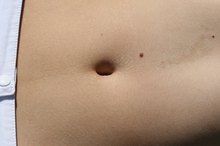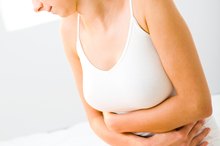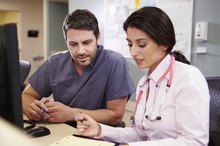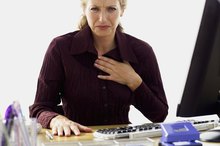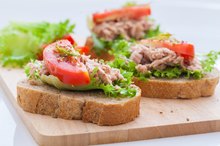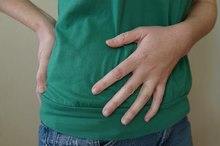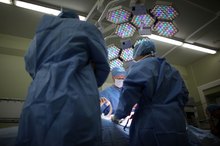Pain in the Upper Right Back After Eating
Pain in the upper part of your back on the right side is most commonly associated with a problem with your gallbladder. The gallbladder is a small pouch-like structure below your liver that stores bile. Bile helps digest the fat that you eat in the small intestine. Gallstones are the most common causes of pain in the upper part of the back on the right after eating.
Gallstones
Several factors can contribute to the formation of gallstones. It is hypothesized that patients who have gallstones have more cholesterol and less bile salts in their bile when it leaves the liver. Gallstones can also be formed if the motility in the gallbladder is slowed. This causes the bile to stay in the gallbladder for an extended period of time, which can then cause stones to form. It is important to consult with your physician if you experience symptoms for a prolonged period of time.
- Several factors can contribute to the formation of gallstones.
- It is hypothesized that patients who have gallstones have more cholesterol and less bile salts in their bile when it leaves the liver.
Symptoms
Can You Exercise if You Have Gallstones?
Learn More
The pain that is felt in the upper portion of the back on the right is typically present after you consume a meal that is high in fat. Many patients also have nausea and may vomit 12 to 18 hours after consuming the high-fat meal. The medical textbook "Rubin's Pathology: Clinicopathic Foundations of Medicine" by Raphael Rubin and colleagues state that people who are at risk for developing gallstones include individuals who are obese, eat meals high in fat and calories or are of Chilean or Northern European descent 1. There is also an increased prevalence of gallstones in women and in people over the age of 40.
- The pain that is felt in the upper portion of the back on the right is typically present after you consume a meal that is high in fat.
Treatment
Your physician may order lab work and a diagnostic ultrasound to determine if you have gallstones. Once it is determined that you do have gallstones, you may undergo a procedure known as a cholecystectomy. A cholecystectomy is usually performed laparoscopically, where the surgeon will remove the gallbladder. The patient is usually released in one day and can return to work in a few days. Some patients report persistent diarrhea after the procedure.
- Your physician may order lab work and a diagnostic ultrasound to determine if you have gallstones.
Prevention
Symptoms of Gallbladder Polyps
Learn More
Gallstones can be prevented, especially in people who are at risk for developing them. Losing weight and staying physically active are two ways that you can prevent the formation of gallstones. Untreated, gallstones can lead to chronic inflammation of the gallbladder known as chronic cholecystitis. Eating a healthy, well-balanced diet that is low in fat and regular checkups with your physician will also decrease your chance of developing gallstones.
- Gallstones can be prevented, especially in people who are at risk for developing them.
Related Articles
References
- "Rubin's Pathology: Clinicopathic Foundations in Medicine"; Raphael Rubin et al.; 2008
- "Differential Diagnosis and Management for the Chiropractor: Protocols and Algorithms"; Thomas A. Souza; 2009
- MayoClinic.com: Gallstones
- National Institute of Diabetes and Digestive and Kidney Diseases. Symptoms & Causes of Gallstones. Updated November 2017.
- Stinton LM, Shaffer EA. Epidemiology of gallbladder disease: cholelithiasis and cancer. Gut Liver. 2012;6(2):172-87. doi:10.5009/gnl.2012.6.2.172
- Johns Hopkins Medicine. Gallstones.
- National Institute of Diabetes and Digestive and Kidney Diseases. Dieting & Gallstones. Updated November 2017.
- Johansson K, Sundström J, Marcus C, Hemmingsson E, Neovius M. Risk of symptomatic gallstones and cholecystectomy after a very-low-calorie diet or low-calorie diet in a commercial weight loss program: 1-year matched cohort study. Int J Obes (Lond). 2014;38(2):279-84. doi:10.1038/ijo.2013.83
- Johns Hopkins Medicine. Gallstones.
- Mayo Clinic Staff. Gallstones. Mayo Clinic. Updated November 17, 2017.
- National Institute of Diabetes and Digestive and Kidney Diseases. Dieting and Gallstones. National Institutes of Health. U.S. Department of Health and Human Services. Updated November 2017.
- National Institute of Diabetes and Digestive and Kidney Diseases. Symptoms and Causes of Gallstones. National Institutes of Health. U.S. Department of Health and Human Services. Updated November 2017.
- Portincasa P, Di Ciaula A, Grattagliano I. Preventing a Mass Disease: The Case of Gallstones Disease: Role and Competence for Family Physicians. Korean Journal of Family Medicine. 2016;37(4):205-213. doi:10.4082/kjfm.2016.37.4.205.
Writer Bio
Nick Patterson is a professional writer specializing in the effects of nutrition on chronic pain and inflammatory conditions. He holds a Bachelor of Science in exercise science from SUNY Buffalo and a Master of Science in applied clinical nutrition from New York Chiropractic College. Patterson is currently pursuing his Doctor of Chiropractic degree.

